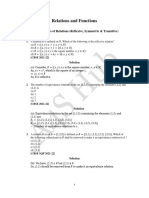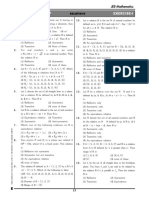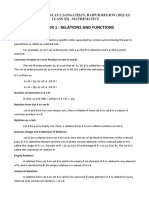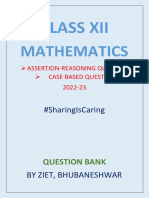0% found this document useful (0 votes)
40 views5 pagesCH 1. Relations and Functions
The document discusses various types of relations in set theory, including empty, universal, identity, reflexive, symmetric, transitive, and equivalence relations. It explains the definitions and properties of these relations, as well as their significance in partitioning sets into equivalence classes. Additionally, the document covers functions, specifically one-one (injective), onto (surjective), and bijective functions, along with multiple-choice and short answer questions related to these concepts.
Uploaded by
defaultuser0808Copyright
© © All Rights Reserved
We take content rights seriously. If you suspect this is your content, claim it here.
Available Formats
Download as PDF, TXT or read online on Scribd
0% found this document useful (0 votes)
40 views5 pagesCH 1. Relations and Functions
The document discusses various types of relations in set theory, including empty, universal, identity, reflexive, symmetric, transitive, and equivalence relations. It explains the definitions and properties of these relations, as well as their significance in partitioning sets into equivalence classes. Additionally, the document covers functions, specifically one-one (injective), onto (surjective), and bijective functions, along with multiple-choice and short answer questions related to these concepts.
Uploaded by
defaultuser0808Copyright
© © All Rights Reserved
We take content rights seriously. If you suspect this is your content, claim it here.
Available Formats
Download as PDF, TXT or read online on Scribd
/ 5





















































































